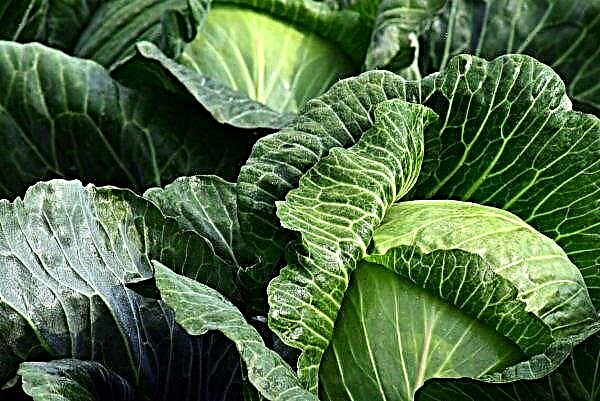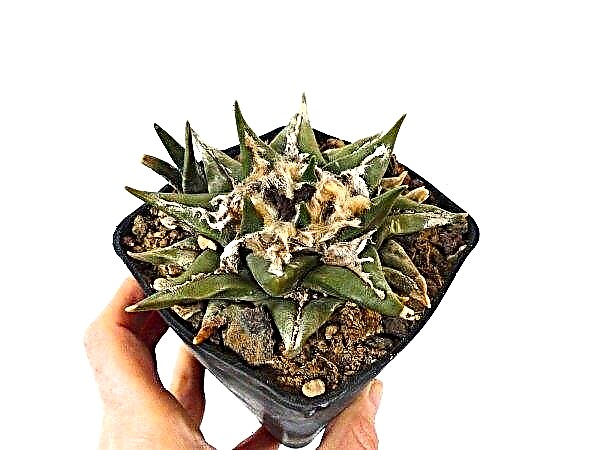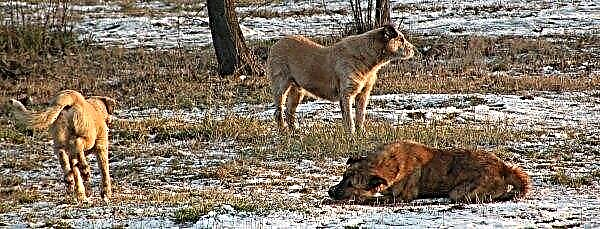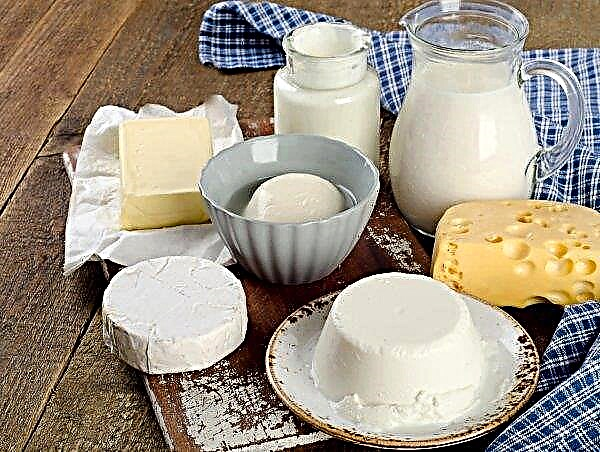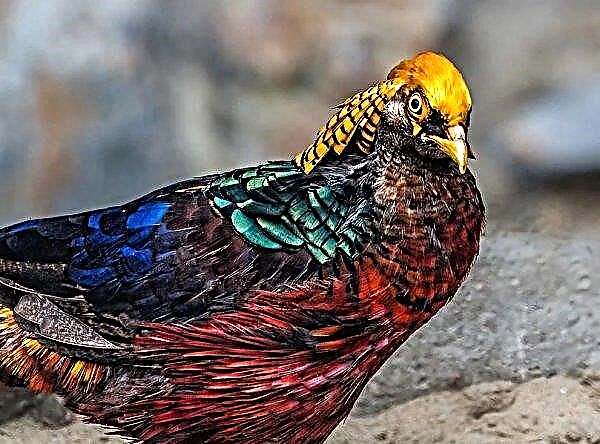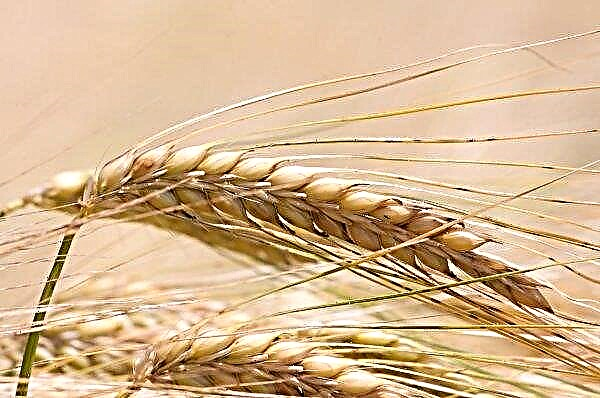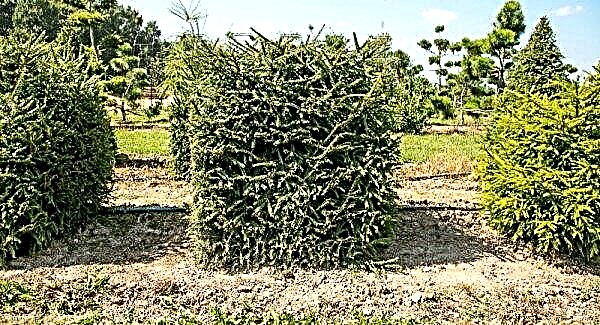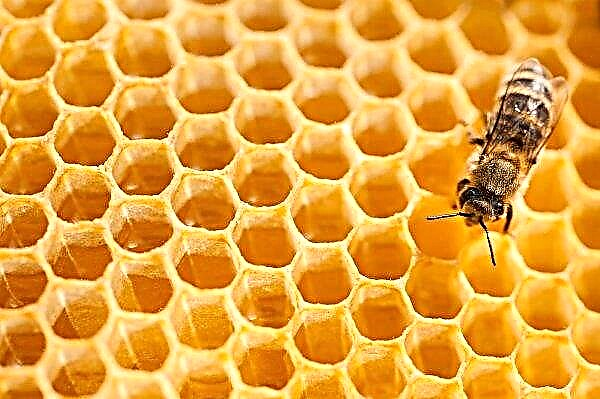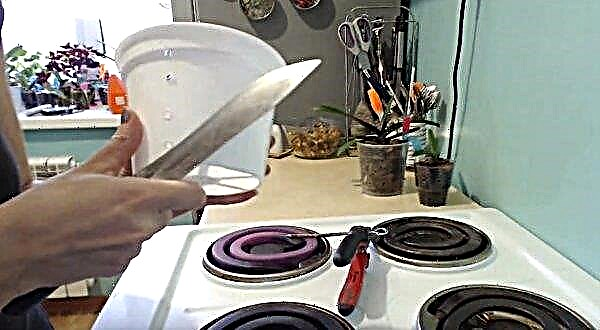Hens of broiler breeds are characterized by universal qualities, because they have a quick set of muscle mass, and also there is a high vitality of the offspring. Next, we will tell you what normative indicators of growth and content of adult broilers of the KOBB-500 cross and chicks exist, and tell you how to cope with possible diseases.
Description of the breed of chickens KOBB-500
KOBB-500 chickens come from the Czech Republic, and today their breeding is a priority in many countries where they are in great consumer demand.
The reasons for the popularity of the described chickens lie in the characteristic of their breed:
- these hens are exclusively meaty, have a skin of a natural yellow hue, which does not change depending on the feed consumed (unpigmented), how they differ from other breeds;
- rapid growth of chicks is present with minimal feed intake;
- roosters and females at different ages have practically no differences in weight, size and commercial quality, which allows not to separate carcasses into varieties in the industrial production of meat.
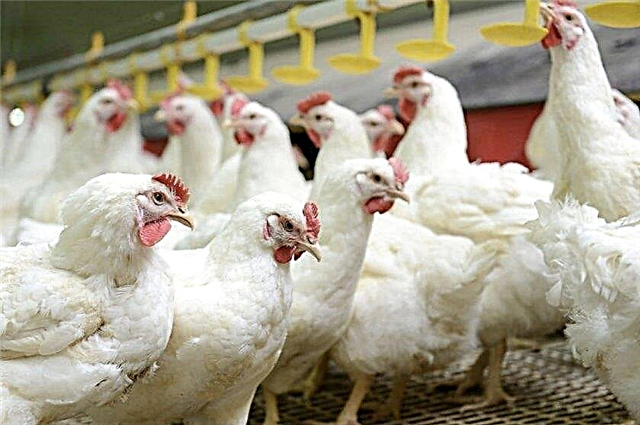 You can conduct a comparative analysis of the described cross with another popular among farmers highly productive ROSS-308, also characterized by universal qualities:
You can conduct a comparative analysis of the described cross with another popular among farmers highly productive ROSS-308, also characterized by universal qualities:
- large egg production;
- high hatchability of offspring;
- rapid growth and maturation;
- large muscles.
Important! If roosters and hens contain separately, then a more rapid mass gain is possible in both sexes.
Appearance
KOBB-500 broilers have a characteristic appearance:
| Appearance | |
| Head | Medium in size, neat, broad forehead, face with reddish skin |
| Crest | Medium Bright Red |
| Beak | Powerful, able to seriously injure |
| Neck | Medium and Strong |
| Chest | Broadish, with increased meatiness, makes up most of the body |
| Stomach | Well developed |
| Wings | Adjacent, small |
| Tail | The male is medium, curved; almost does not stand out in chicken |
| Paws | Large, high standing, strong |
| Plumage and color | Thick, dense, exceptionally white |
As the table showed, the external characteristics of the described cross are easily distinguishable from the qualities of chickens of other breeds due to their massive body, high powerful paws and well-developed chest.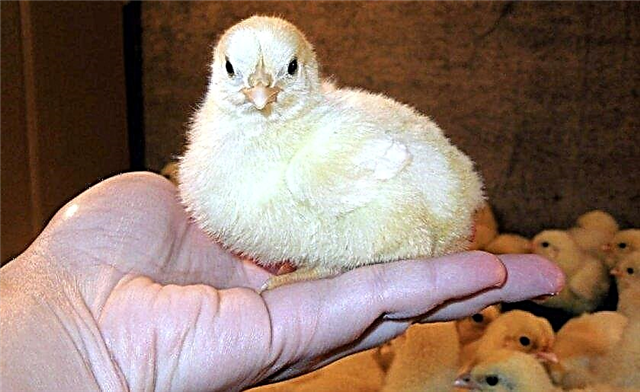 From the table it follows that broilers of the indicated cross have excellent characteristics of meat productivity, but as laying hens for production use are not suitable due to low egg production.
From the table it follows that broilers of the indicated cross have excellent characteristics of meat productivity, but as laying hens for production use are not suitable due to low egg production.
Temperament
KOBB-500 broilers differ in the following temperament:
- roosters and hens of the breed are not aggressive, at home are quite balanced, do not fight and do not make noise unnecessarily;
- there is no fear of a person;
- cannibalism is possible due to insufficient feeding or too bright lighting;
- the phlegmatic nature of the birds allows them to be kept without walking in the walking yard, due to which the rate of muscle gain is increasing.
Important! If a broiler chicken develops an inflammation of the cloaca or a wound from mechanical damage, its fellow tribesmen are able to peck this place until its death, therefore it is very important to pay due attention to sick pets in order to isolate the rest of the livestock from them in time.
Advantages and disadvantages of the breed
- "Five hundredth" chickens have several advantages:
- Chickens are suitable for raising them both in poultry complexes and in a personal farmstead.
- In a fairly short time, a tangible weight gain is possible, allowing the bird to be slaughtered from a month old.
- Carcasses have an excellent presentation due to the yellow color of the skin.
- Birds have rather muscular thighs.
- A small layer of fat.
- Breast with a large weight and a pleasant taste.
- Low feed costs.
- High survival rate of young animals (95–98%).
- Unpretentiousness of the content.
- Reduced susceptibility to chicken disease.
- Equal weight gain in roosters and hens.
- High percentage of carcass yield.
- Low final price of meat products.
- The disadvantages of the breed include:
- They do not tolerate cold, which increases energy costs during detention in harsh climatic zones.
- Self-breeding is difficult due to the hybrid breed.
- Loss of ability to hatch and raise young animals.
- Low egg production.
Despite a number of shortcomings of the breed, they are significantly outweighed by positive qualities, which is highly appreciated by breeders.
Photo gallery
Growing COBB-500 at home
Growing broilers in the household involves proper care and care for pets.
Did you know? Scientists from Canada analyzed the changes in the development of ordinary chicken over the past 60 years. During the experiment, two breeds of broilers, popular in the 50s and 70s of the twentieth century, as well as one modern breed were placed in the same growing conditions. The results were stunned: the rate of increase in muscle mass in modern hens was 4 times higher, which is explained by the achievements of modern selection.
Conditions of detention
The conditions of their maintenance are very important for Czech broilers, since they will contribute to the rapid gain in body weight.
Requirements for the conditions of detention:
- Provide low activity and peace of the bird. To do this, do not let the bird out onto the walking yard, as well as allow contact with other pets. It is very important to keep the livestock away from possible noise interference (busy tracks).
- Temperature. Broilers should not be kept at too high or too low a temperature. For their comfort, it is necessary to ensure the optimum temperature of the content +27 ... + 33 ° С.
- Lighting. The first 2 weeks of life, broilers organize lighting around the clock, then reduce the hours of its filing. The illumination in the chicken coop should be dim (it is advisable to use infrared lamps) so as not to provoke increased energy of the birds.
- Cleanliness in the chicken coop. Compliance with the clean conditions of broilers will serve as the prevention of diseases and mortality. To do this, sprinkle the flooring in the room with straw, hay or sawdust, change the soiled litter daily, and make sure that feeders and drinking bowls are cleaned of residual wet feed and dirty water on time.
- Good ventilation. Unacceptable in a chicken coop with broilers stuffiness, as well as drafts. Therefore, livestock provide well-organized ventilation in the room and close all possible openings in the walls. In a well-ventilated area, it is possible to contain more heads.
- Humidity. The most favorable level of humidity in the chicken coop during broiler keeping is not higher than 50–55%.
- Proper nutrition. The broiler diet should contain a sufficient amount of protein, vitamins, mineral supplements and trace elements.

Feeding
The correct diet for the KOBB-500 cross is able to provide the highest productivity of the bird. The best solution for birds will be specialized feed, which includes all the necessary vitamin and mineral kit, and the main components in it will satisfy all the needs of actively growing chickens. In order for the weight gain to be constant, it is necessary to select feed for hens in accordance with their age.
Below are the tables in which we indicate the average ratio of the weight of broilers at different ages by day and feed consumption, as well as how to feed young and adult birds by the day.
Chickens
Feeding of young animals occurs according to the following scheme:
- the first four days the chicks feed 8 times a day;
- from the fifth day they are transferred to a 7-time feed intake.
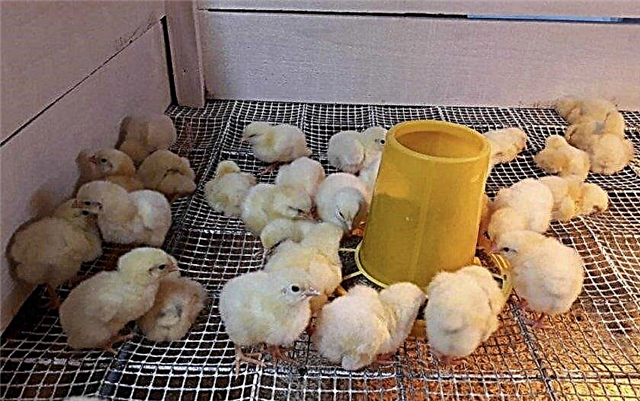 The daily diet of chickens, including high-quality compound feed, is as follows:
The daily diet of chickens, including high-quality compound feed, is as follows:| Age (days) | Weight by day (g) | What to feed | Feed consumption (g / day) |
| 1 | 0,053 | from 1st to 10th day - Starter + 21% crude protein | 14 |
| 2 | 0,065 | 14 | |
| 3 | 0,081 | 15 | |
| 4 | 0,101 | 16 | |
| 5 | 0,122 | 22 | |
| 6 | 0,141 | 25 | |
| 7 | 0,167 | 28 | |
| 8 | 0,194 | 31 | |
| 9 | 0,225 | 35 | |
| 10 | 0,257 | 39 | |
| 11 | 0,294 | from the 11th to the 22nd days - Rostov + 19% crude protein | 44 |
| 12 | 0,335 | 49 | |
| 13 | 0,378 | 55 | |
| 14 | 0,426 | 61 | |
| 15 | 0,479 | 68 | |
| 16 | 0,533 | 75 | |
| 17 | 0,588 | 83 | |
| 18 | 0,648 | 91 | |
| 19 | 0,713 | 99 | |
| 20 | 0,779 | 106 | |
| 21 | 0,847 | 112 | |
| 22 | 0,915 | 118 |
In addition to feed, broiler chickens are given the following food:
- fresh greens (from the 5th day);
- vegetable mixes (mashed potatoes, carrots, pumpkin - from the 7th day);
- dairy products (whey, cottage cheese);
- crushed grain.
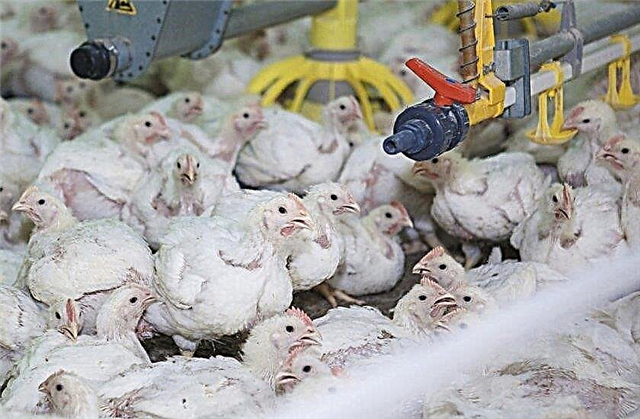
Adults
The nutritional schedule of adults is as follows:
| Age (days) | Weight by Day (g) | What to feed | Feed Consumption (g / day) |
| 23 | 0,989 | from the 23rd to the 42nd day - Finisher 1 + 18% crude protein | 123 |
| 24 | 1,063 | 128 | |
| 25 | 1,138 | 133 | |
| 26 | 1,212 | 137 | |
| 27 | 1,291 | 141 | |
| 28 | 1,369 | 145 | |
| 29 | 1,448 | 149 | |
| 30 | 1,528 | 153 | |
| 31 | 1,609 | 157 | |
| 32 | 1,691 | 160 | |
| 33 | 1,774 | 163 | |
| 34 | 1,858 | 166 | |
| 35 | 1,943 | 169 | |
| 36 | 2,028 | 172 | |
| 37 | 2,113 | 175 | |
| 38 | 2,197 | 177 | |
| 39 | 2,278 | 179 | |
| 40 | 2,362 | 181 | |
| 41 | 2,443 | 182 | |
| 42 | 2,521 | 183 | |
| 43 | 2,602 | 43rd to 49th Day - Finisher 2 + 17% crude protein | 184 |
| 44 | 2,678 | 185 | |
| 45 | 2,755 | 186 | |
| 46 | 2,834 | 187 | |
| 47 | 2,908 | 188 | |
| 48 | 2,985 | 188 | |
| 49 | 3,059 | 188 |
In addition to feed, the following products are added to the feed from the 20th day of life to an adult bird:
- potatoes (boiled);
- fresh vegetables (carrots, pumpkin);
- sunflower meal;
- dairy products;
- Fresh fish
- fresh greens (grass meal);
- bread yeast diluted with milk or water;
- sprouted wheat;
- whole grain (from the 1st month);
- dry blades of grass (in winter);
- eggshell;
- pharmacy vitamins.
In the process of fattening the cross, it is important to adhere to the general requirements for drinking bowls and feeders for broilers, established in accordance with zootechnical standards:Important! Containing COBB-500 for more than 4 months is impractical because, by consuming a large amount of feed, such individuals no longer significantly increase their weight.
- grooved food provides for 2.5 cm of space per head;
- feed from round feeders should be based on the calculation of 45–70 individuals per feeder;
- with nipple watering of the herd, 10–12 individuals per device are permissible;
- the presence of a vacuum drinking bowl causes the drinking of 50 goals;
- with the grooved method of drinking, 20 cm are allocated for each individual.
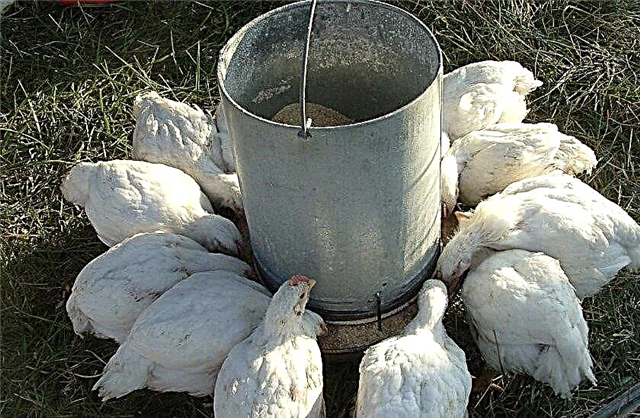
Incubation mode
Incubation of the eggs of the described cross should occur in several stages:
- Material selection. Eggs should be medium in size, regular in shape, with a hollow shell, smooth and clean. They must also be examined with an ovoscope to discard material with defects that are invisible to the eye.
- Storage. The recommended shelf life is three days at a temperature of +18 ° C. The humidity level is 85%.
- Preparing for laying in an incubator. Eggs must be warmed for 8 hours at a temperature of +22 ° C. The incubator is thoroughly washed, disinfected and dried.
- Bookmark material. The best time for laying eggs is in the evening (at 18 o’clock), since the chicks will thus begin to hatch early in the morning, and by the evening the entire brood will be born.
- Actions after the bookmark. From the 1st to the 7th day, the temperature in the incubator should be + 37.8 ° C and humidity 55%; from the 8th to the 14th day, the temperature remains at the same level, and the humidity decreases slightly - up to 45%; from the 15th to the 18th day, keep the temperature at +37.8 ° C, and increase the humidity to 50%; from the 19th to the 21st days the temperature is +37.5 ° C, and the humidity is 65%.
- Twists and turns. Turn the eggs in the incubator three or four times a day at 90 ° (so that the embryo does not stick to the inner shell of the shell). It is also necessary so that the heat is evenly distributed and the oxygen supply process is improved. Three to four days before hatching, rotation is stopped.
- Spraying. Humidification of eggs is necessary only at low humidity in the incubator. To do this, from the first to the tenth day they are sprayed from the spray gun to maintain a 30% level of moisture; from the eleventh to the eighteenth day, the moisture content of the eggs should reach 70%.
- Ventilation. The eggs are able to “breathe” and release carbon dioxide, and this can inhibit the process of embryo development, therefore, from the 14th day, a 15-minute ventilation of the material laid in the incubator at a temperature of +18 ... + 25 ° C is necessary.
- Ovoscopy. On the sixth and seventeenth day, it is necessary to examine each egg with an ovoscope to track the development of the embryos.
- The exit of chickens. At the time of hatching of the chicks, they need to provide sufficient air humidity so that they can freely break the shell-shell, therefore, an additional tray with water must be installed in the incubator. Another important aspect is the sufficient amount of oxygen. If you observe all these nuances, then the chicks will be comfortable: they will signal this with a quiet squeak; if they are cold or they feel different discomfort, their squeak will be loud and alarming.
Video: Bookmark, incubation and withdrawal of COBB-500
Did you know? Newborn female chickens already have thousands of microscopic eggs, which are undeveloped yolks, which only at the beginning of puberty will fall into the fallopian tube for their further development.
Possible bird diseases
Although KOBB-500 cross hens are poorly susceptible to disease, they can still be exposed to chicken diseases. Here are the most common broiler diseases and how to treat them:
- Dyspeptic conditions. The disease is caused by spoiled feed (expired) or inappropriate age of the livestock. Since young animals do not have complete digestion right after birth, a lack of enzymes leads to severe poisoning, accompanied by white-yellow diarrhea with the remains of undigested food. To solve the problem, it is necessary to remove the cause of the disease - eliminate poor-quality or spoiled food. Young animals are made up of the correct diet in accordance with age (with proteins, carbohydrates and vitamin-mineral composition). Daily thorough cleaning of feeding troughs, drinking bowls and premises, as well as their disinfection once every 5 days is required. For therapeutic and prophylactic purposes, chicks are prescribed acidophilic broth culture (ABA) and propionic acidophilus broth culture (PABA) in the doses recommended by the veterinarian.
- Bronchopneumonia. Most often occur due to hypothermia. Ill chicks breathe heavily with open beaks, their breathing is accompanied by wheezing and elongation of necks.
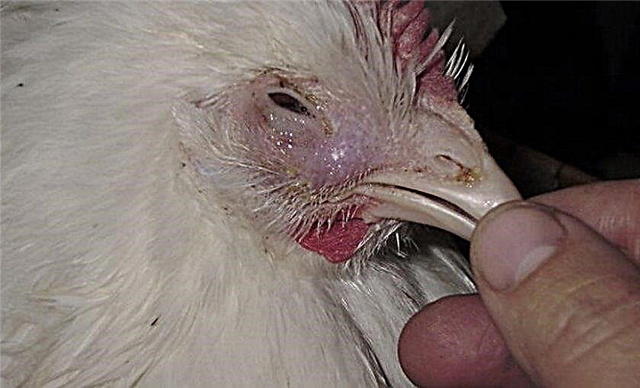 To eliminate the problem, it is necessary to put the young in warm conditions. Treatment is carried out with Enroflon 10% and Tetracycline, which are prescribed by a veterinarian.
To eliminate the problem, it is necessary to put the young in warm conditions. Treatment is carried out with Enroflon 10% and Tetracycline, which are prescribed by a veterinarian. - Marek's disease. Over 80% of the livestock can be affected. At the same time, the bird becomes lame, sagging wings and tails, twisting of the neck, impaired vision. The main protection measure is timely vaccination. It is important to remember that to cure this disease is possible only at an early stage of infection. To make an accurate diagnosis and prescribe treatment, you must definitely contact your veterinarian.
- Vitamins. Since broilers grow rapidly, sometimes they have an acute shortage of vitamins in the body, so you need to carefully monitor the vitamin composition of the feed. Also, the veterinarian will prescribe additional vitamin preparations, if necessary (Chiktonik and others).
- Enteritis. With these diseases in young animals, the gastrointestinal system is affected. To resolve the problem, you need to contact a veterinary clinic, where the doctor will prescribe antibacterial drugs (Iodinol, Vetom 1.1, etc.).
- Aspergillosis The disease is caused by a fungal infection and affects the respiratory system. The cause of the infection may be a violation of the conditions of the bird, in which the fungus enters a favorable environment and multiplies. For prevention purposes, the premises, as well as feeders and drinking bowls, must be kept clean and disinfected. Treatment is carried out with antifungal drugs (Voriconazole, Amphotericin, Itraconazole, etc.), the duration and dosage of which can only be prescribed by a doctor.
- Salmonellosis Particularly dangerous disease, since not only chickens, but also humans are infected.When infected, the sick bird is not treated, but slaughtered without use in food.
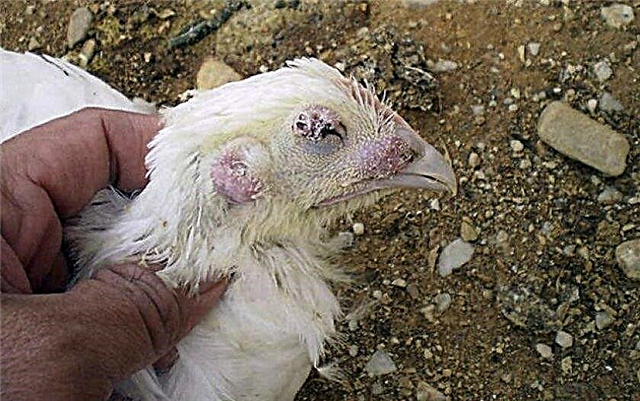

 To eliminate the problem, it is necessary to put the young in warm conditions. Treatment is carried out with Enroflon 10% and Tetracycline, which are prescribed by a veterinarian.
To eliminate the problem, it is necessary to put the young in warm conditions. Treatment is carried out with Enroflon 10% and Tetracycline, which are prescribed by a veterinarian.